Why Apex Seals Fail
#1
Why Apex Seals Fail
Most people think that that their apex seal failures are caused by detonation. More specifically, they think the detonation was caused by some combination of poor fuel, advanced ignition, and high boost. This can and does happen but is not the root cause of the seal breakage.
One of my engines, which I thought would run a very long time because of reliability mods and low boost (14psi), lost an apex seal at about 30K miles. The only good news was that upon close examination I discovered a second apex seal in the set that was cracked but had not yet broken. (Sorry the magnification isn't better.)
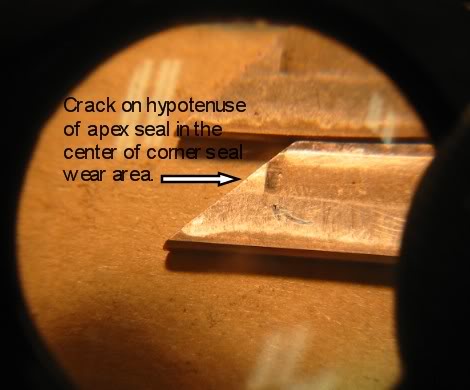
I was surprised to find crack was emanating from the bottom side not at the exposed working face!
It makes perfect sense. The main part of the seal is supported unevenly at three points. The forth spring contact point is on the wedge portion of the seal. When the seal rocks over the high point in the housing, specifically, the spark plug openings, the tip is under pressure from the wedge.
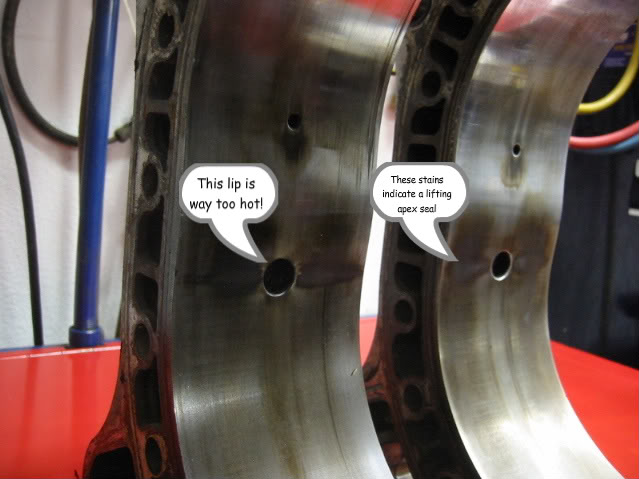
One of my engines, which I thought would run a very long time because of reliability mods and low boost (14psi), lost an apex seal at about 30K miles. The only good news was that upon close examination I discovered a second apex seal in the set that was cracked but had not yet broken. (Sorry the magnification isn't better.)

I was surprised to find crack was emanating from the bottom side not at the exposed working face!
It makes perfect sense. The main part of the seal is supported unevenly at three points. The forth spring contact point is on the wedge portion of the seal. When the seal rocks over the high point in the housing, specifically, the spark plug openings, the tip is under pressure from the wedge.

#2
So you can try a little experiment to test this hypothesis. Install a .0015 feeler gauge at the center of the apex seal simulating the raised spark plug area. The seal will be rocked-over .003 and the wedge will put pressure on the pointed end of the apex seal. Note the exaggerated condition depicted at the top of the picture.
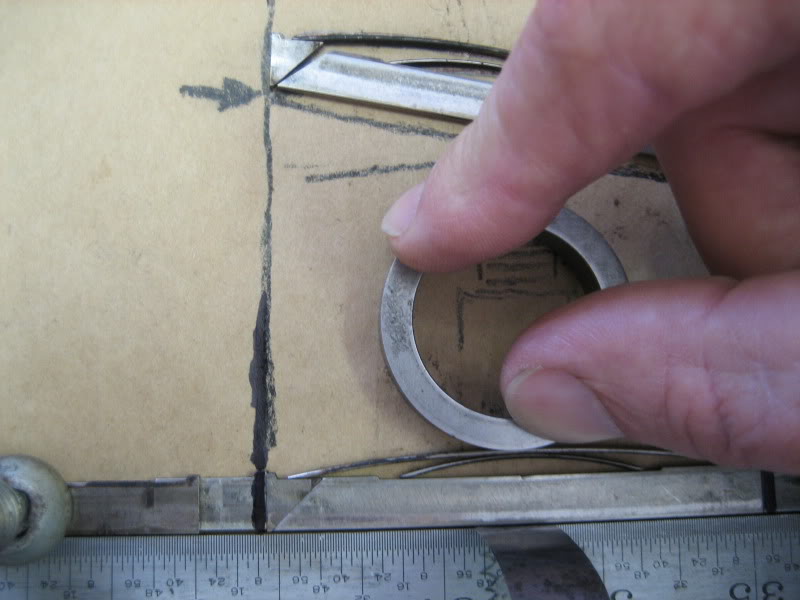
But we still havent gotten to the root cause. The real problem is the raised spark plug area on the housing. There are at least three approaches to this problem:
(1)- Use cold heat range plugs like NGK R7420-10 or 10.5. (This is easiest part of the solution.)
(2)-The harder second part is to cool the housing better.
A better pump is a good start. Second gen. cast impeller type pumps are a lot better or the Remedy pump for 3rd gens.
(3)-The most difficult part would be to port the housing in the spark plug area to minimize distortion.
But what is the best way?
The factory racing peripheral housing have a trough cast into the inner water jacket in this area but the are for NA applications.
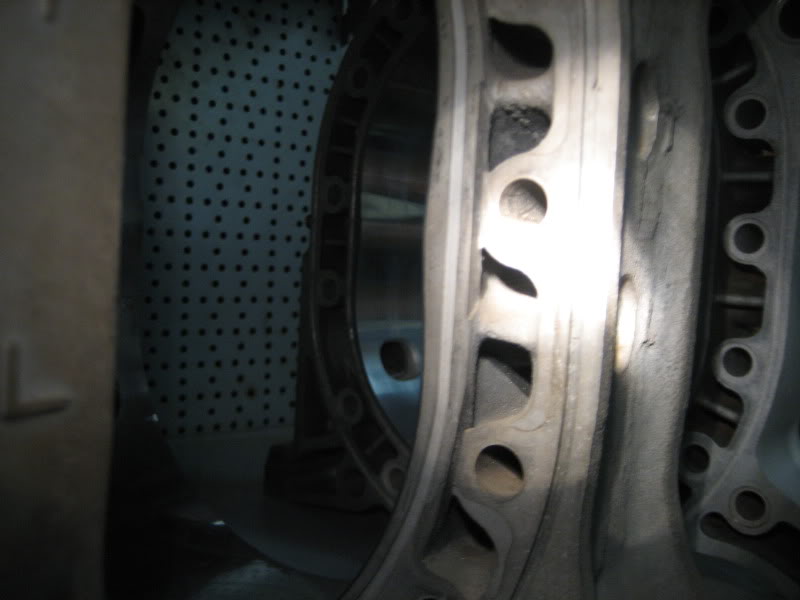
Notice that the thru-bolt bosses have been severed.

But we still havent gotten to the root cause. The real problem is the raised spark plug area on the housing. There are at least three approaches to this problem:
(1)- Use cold heat range plugs like NGK R7420-10 or 10.5. (This is easiest part of the solution.)
(2)-The harder second part is to cool the housing better.
A better pump is a good start. Second gen. cast impeller type pumps are a lot better or the Remedy pump for 3rd gens.
(3)-The most difficult part would be to port the housing in the spark plug area to minimize distortion.
But what is the best way?
The factory racing peripheral housing have a trough cast into the inner water jacket in this area but the are for NA applications.

Notice that the thru-bolt bosses have been severed.
#5
I have been thinking about this also and I turned to the Ro80 rotor housings for answers. What NSU did was to make the entire boss out of copper with a press fit into a bore. This boss was then tapped for a spark plug.
My thought has been what if we were to use a holesaw and cut the boss free of the outer rotor housing wall and cut the webbing free as well. This way as the sparkplug boss heats up and expands it will be able to expand out instead of push into the inner housing wall. We could even machine it to where we could have a threaded nut with a pair of o-rings that can work back and forth along the spark plug boss' outer surface. All we really need is an o-ring material that would stand up to the heat.
My thought has been what if we were to use a holesaw and cut the boss free of the outer rotor housing wall and cut the webbing free as well. This way as the sparkplug boss heats up and expands it will be able to expand out instead of push into the inner housing wall. We could even machine it to where we could have a threaded nut with a pair of o-rings that can work back and forth along the spark plug boss' outer surface. All we really need is an o-ring material that would stand up to the heat.
#6
Well, I would try and do better machining than a hole saw but I get the jist of your idea. If the nice water tight press fit was in the "front" of the jacket only (the area at the tip of the plug) A slip fit and o-rings at the back would still allow for thermal expansion differences and put the o-rings in a more temperature friendly place. Some sort of positive safety against unwanted/accidental removal during operation such as a snap ring would also be prudent.
Why not aluminum instead of copper? I know copper will get rid of heat better (aluminum is no slacker at thermal conductivity either), but a a nice bored hole, getting rid of a lot of material and a THINNER due to the fact it is machined and not cast with draft, sleeve could still offer improvements. Thermal expansion differences between copper and aluminum plus electrolysis effect, cause other problems.Just some thoughts as a machinists.
Why not aluminum instead of copper? I know copper will get rid of heat better (aluminum is no slacker at thermal conductivity either), but a a nice bored hole, getting rid of a lot of material and a THINNER due to the fact it is machined and not cast with draft, sleeve could still offer improvements. Thermal expansion differences between copper and aluminum plus electrolysis effect, cause other problems.Just some thoughts as a machinists.
Last edited by TonyD89; 10-02-09 at 07:16 PM.
#7
I have been thinking about this also and I turned to the Ro80 rotor housings for answers. What NSU did was to make the entire boss out of copper with a press fit into a bore. This boss was then tapped for a spark plug.
My thought has been what if we were to use a holesaw and cut the boss free of the outer rotor housing wall and cut the webbing free as well. This way as the sparkplug boss heats up and expands it will be able to expand out instead of push into the inner housing wall. We could even machine it to where we could have a threaded nut with a pair of o-rings that can work back and forth along the spark plug boss' outer surface. All we really need is an o-ring material that would stand up to the heat.
My thought has been what if we were to use a holesaw and cut the boss free of the outer rotor housing wall and cut the webbing free as well. This way as the sparkplug boss heats up and expands it will be able to expand out instead of push into the inner housing wall. We could even machine it to where we could have a threaded nut with a pair of o-rings that can work back and forth along the spark plug boss' outer surface. All we really need is an o-ring material that would stand up to the heat.
TonyD89 can a surface be machined smooth enough so the o-rings would seal well?
Barry
Trending Topics
#8
Joined: Mar 2001
Posts: 30,580
Likes: 567
From: FL-->NJ/NYC again!
I am using the 6725 plugs currently and have some 7420s coming in from Japan-land.
Another easy change (depending on your climate) is to run more water/less coolant. Most of us tool around with 50/50 because it's easy, the default.
Another easy change (depending on your climate) is to run more water/less coolant. Most of us tool around with 50/50 because it's easy, the default.
#11
Originally Posted by Barry Bordes
TonyD89 can a surface be machined smooth enough so the o-rings would seal well?

#13
Um.
"Cold" spark plugs don't actually run colder, they just have a shorter path of heat transfer to the threads.
I don't think that it would actually result in colder temps at the spark plug hole.
Anybody with a chassis dyno, various spark plugs, and some shim-under spark plug temp probes feel like doing an experiment?
"Cold" spark plugs don't actually run colder, they just have a shorter path of heat transfer to the threads.
I don't think that it would actually result in colder temps at the spark plug hole.
Anybody with a chassis dyno, various spark plugs, and some shim-under spark plug temp probes feel like doing an experiment?
#14
 I'm going to be running around 20 - 22psi all day as well with water injection pre turbo so the guys that have proven this setup all say r7420 10.5's are the way to go. I just figured I'd split up the plugs I'm getting and the ones I've already got so I can have two sets of every day plugs since both sets cost me about 300 bucks
I'm going to be running around 20 - 22psi all day as well with water injection pre turbo so the guys that have proven this setup all say r7420 10.5's are the way to go. I just figured I'd split up the plugs I'm getting and the ones I've already got so I can have two sets of every day plugs since both sets cost me about 300 bucks 
Last edited by hondahater; 10-03-09 at 07:33 PM.
#15
You have a bad tune,this is why the housings are distorting from to much heat.you can do alot of mods to cover it up but is just simply what you will be doing,just covering up a problem.
Bad tune is the main cause of broken apex seals.
Brent
Bad tune is the main cause of broken apex seals.
Brent
#16
-J
#17
Most certainly. Things like reamers and boring tools will do the trick and are nice for guys with a Bridgeport milling machine or a good drill press. Simple and easy. Myself, I would follow what I'm accustomed to and circular interpolate the hole in a CNC milling machine.

#18
Um.
"Cold" spark plugs don't actually run colder, they just have a shorter path of heat transfer to the threads.
I don't think that it would actually result in colder temps at the spark plug hole.
Anybody with a chassis dyno, various spark plugs, and some shim-under spark plug temp probes feel like doing an experiment?
"Cold" spark plugs don't actually run colder, they just have a shorter path of heat transfer to the threads.
I don't think that it would actually result in colder temps at the spark plug hole.
Anybody with a chassis dyno, various spark plugs, and some shim-under spark plug temp probes feel like doing an experiment?
Is it heat at the plugs tip a result of:
(1) The heat of the combustion transmitted to surface area of insulator heating the plug.
(2) The electrical current firing the plug.
(3) A combination of (1) and (2).
#19
Kenichi Yamamoto might disagree with you. Most people treat it as an inherent problem and we are trying to solve/minimize it. Your help would be great.
Thanks,
Barry
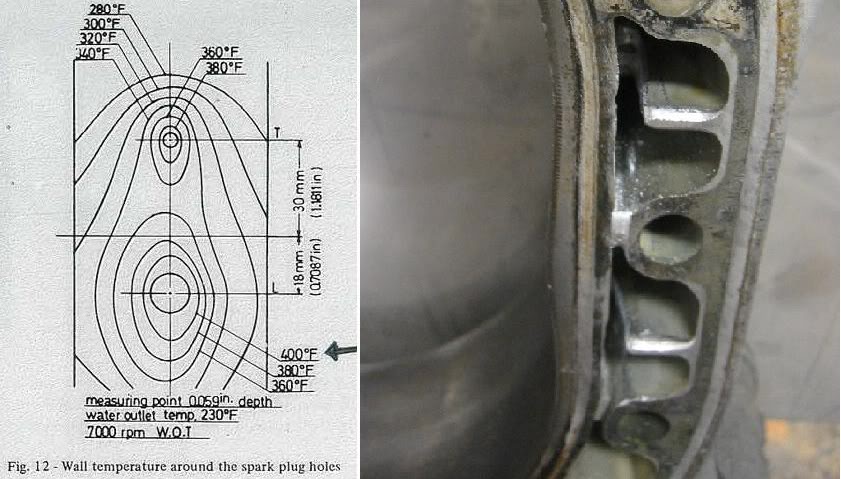
#21
I have seen this problem many times especialy in high output track engines,I did many mods like you are doing to help the problem,I even ran external water lines from the radiater to the housings which made a big difference especialy on the rear rotors of the 20b.
I have since changed my way of tuning and have found no need for these mods any more.
I dont see any carbon build up on housings.
Now with a happy tune up water temps dont go past 78deg C and not only on 450+hp 13b's but also 600hp 20b's.
even with 800+hp drag setups I dont see this anymore.
Also I have never done it like the last pic but would be worried that the housing would move even more under load.
Brent
I have since changed my way of tuning and have found no need for these mods any more.
I dont see any carbon build up on housings.
Now with a happy tune up water temps dont go past 78deg C and not only on 450+hp 13b's but also 600hp 20b's.
even with 800+hp drag setups I dont see this anymore.
Also I have never done it like the last pic but would be worried that the housing would move even more under load.
Brent
#22
I have seen this problem many times especialy in high output track engines,I did many mods like you are doing to help the problem,I even ran external water lines from the radiater to the housings which made a big difference especialy on the rear rotors of the 20b.
I have since changed my way of tuning and have found no need for these mods any more.
I dont see any carbon build up on housings.
Now with a happy tune up water temps dont go past 78deg C and not only on 450+hp 13b's but also 600hp 20b's.
even with 800+hp drag setups I dont see this anymore.
Also I have never done it like the last pic but would be worried that the housing would move even more under load.
Brent
I have since changed my way of tuning and have found no need for these mods any more.
I dont see any carbon build up on housings.
Now with a happy tune up water temps dont go past 78deg C and not only on 450+hp 13b's but also 600hp 20b's.
even with 800+hp drag setups I dont see this anymore.
Also I have never done it like the last pic but would be worried that the housing would move even more under load.
Brent
#23
I have seen this problem many times especialy in high output track engines,I did many mods like you are doing to help the problem,I even ran external water lines from the radiater to the housings which made a big difference especialy on the rear rotors of the 20b.
I have since changed my way of tuning and have found no need for these mods any more.
I dont see any carbon build up on housings.
Now with a happy tune up water temps dont go past 78deg C and not only on 450+hp 13b's but also 600hp 20b's.
even with 800+hp drag setups I dont see this anymore.
Also I have never done it like the last pic but would be worried that the housing would move even more under load.
Brent
I have since changed my way of tuning and have found no need for these mods any more.
I dont see any carbon build up on housings.
Now with a happy tune up water temps dont go past 78deg C and not only on 450+hp 13b's but also 600hp 20b's.
even with 800+hp drag setups I dont see this anymore.
Also I have never done it like the last pic but would be worried that the housing would move even more under load.
Brent
That sounds great. It appears that we are trying to achieve exactly the same goals.... moderately high but reliable power. We need your expertise and experience. What are we missing?
Thanks,
Barry
#24
... and the room goes silent. This is one of the biggest problems in the racing community. I KNOW the puerto ricans and the aussies have tuning down pat however it's a secret. So us "yanks" are left sort of in the dark to figure it out all over again. where is the rotary love  All these secrets do nothing but hold back the potential of these rotary motors. Oh well props to you guys for figuring out these tuning secrets.
All these secrets do nothing but hold back the potential of these rotary motors. Oh well props to you guys for figuring out these tuning secrets.
 All these secrets do nothing but hold back the potential of these rotary motors. Oh well props to you guys for figuring out these tuning secrets.
All these secrets do nothing but hold back the potential of these rotary motors. Oh well props to you guys for figuring out these tuning secrets.
#25
Moderator
iTrader: (3)
Joined: Mar 2001
Posts: 31,197
Likes: 2,825
From: https://www2.mazda.com/en/100th/
... and the room goes silent. This is one of the biggest problems in the racing community. I KNOW the puerto ricans and the aussies have tuning down pat however it's a secret. So us "yanks" are left sort of in the dark to figure it out all over again. where is the rotary love  All these secrets do nothing but hold back the potential of these rotary motors. Oh well props to you guys for figuring out these tuning secrets.
All these secrets do nothing but hold back the potential of these rotary motors. Oh well props to you guys for figuring out these tuning secrets.
 All these secrets do nothing but hold back the potential of these rotary motors. Oh well props to you guys for figuring out these tuning secrets.
All these secrets do nothing but hold back the potential of these rotary motors. Oh well props to you guys for figuring out these tuning secrets.CBR says "water temps dont go past 78deg C"
do you think lowering the water temp by more than 60 degrees F changes the rotor housing temp?



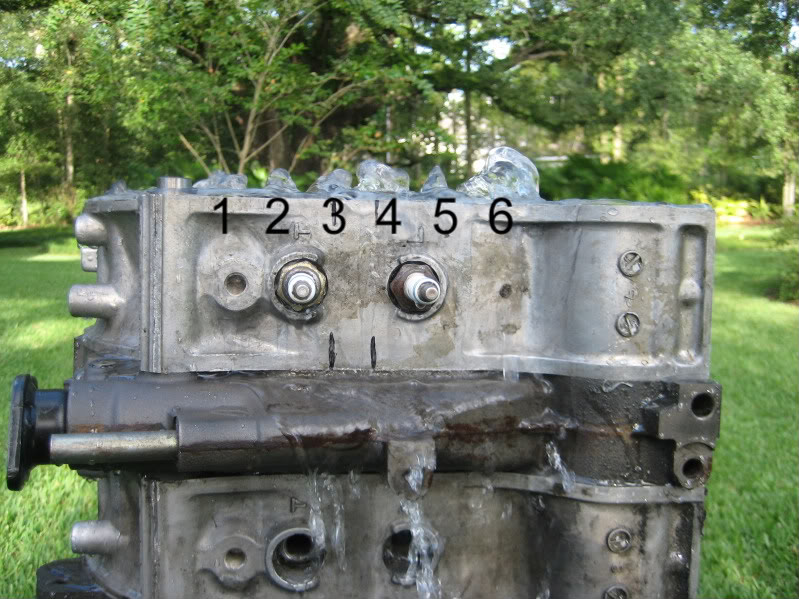

 I'll be running the 7420 10.5's in the leading and some 6725 11.5's in the trailing.
I'll be running the 7420 10.5's in the leading and some 6725 11.5's in the trailing.